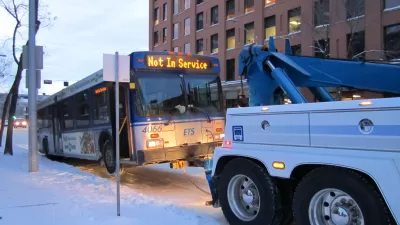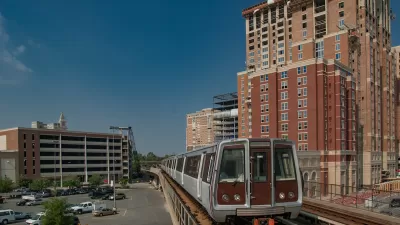Vox brings out the subtleties in explaining the underperformance of the U.S. public transportation system.

Joseph Stromberg writes an article about the state of transportation in the United States that's part explainer and part polemic by asking the question: "The US spends a ton of money on public transportation. So why is it so terrible?"
After citing some statistics to back up the claim that transit systems in Europe and Asia outperform U.S. transit, Stromberg first debunks a common scapegoat for the woes of transit in the United States: "Most of our cities and suburbs were built out after the 1950s, when the car became the dominant mode of transportation. Consequently, we have sprawling, auto-centric metropolises that just can't be easily served by public transportation."
Canada, however, can be cited as an example of country with a similar development pattern that managed to avoid the ravages of poor transit. Finally, Stromberg settles on his answer: "European, Asian, and Canadian cities treat it as a vital public utility. Most American policymakers — and voters — see transit as a social welfare program."
The article goes into a lot more detail about how exactly the politics of mobility achieved its effect in the United States, as well as describing more consequences of, and potential responses to, the state of public transportation.
FULL STORY: The real reason American public transportation is such a disaster

Pennsylvania Mall Conversion Bill Passes House
If passed, the bill would promote the adaptive reuse of defunct commercial buildings.

Coming Soon to Ohio: The Largest Agrivoltaic Farm in the US
The ambitious 6,000-acre project will combine an 800-watt solar farm with crop and livestock production.

World's Largest Wildlife Overpass In the Works in Los Angeles County
Caltrans will soon close half of the 101 Freeway in order to continue construction of the Wallis Annenberg Wildlife Crossing near Agoura Hills in Los Angeles County.

California Grid Runs on 100% Renewable Energy for Over 9 Hours
The state’s energy grid was entirely powered by clean energy for some portion of the day on 37 out of the last 45 days.

New Forecasting Tool Aims to Reduce Heat-Related Deaths
Two federal agencies launched a new, easy-to-use, color-coded heat warning system that combines meteorological and medical risk factors.

AI Traffic Management Comes to Dallas-Fort Worth
Several Texas cities are using an AI-powered platform called NoTraffic to help manage traffic signals to increase safety and improve traffic flow.
City of Costa Mesa
Licking County
Barrett Planning Group LLC
HUD's Office of Policy Development and Research
Mpact Transit + Community
HUD's Office of Policy Development and Research
Tufts University, Department of Urban and Environmental Policy & Planning
City of Universal City TX
ULI Northwest Arkansas
Urban Design for Planners 1: Software Tools
This six-course series explores essential urban design concepts using open source software and equips planners with the tools they need to participate fully in the urban design process.
Planning for Universal Design
Learn the tools for implementing Universal Design in planning regulations.


























